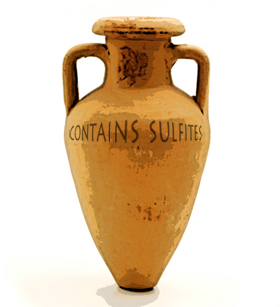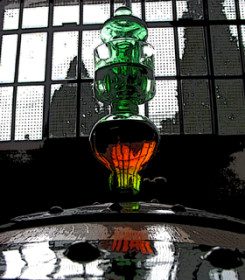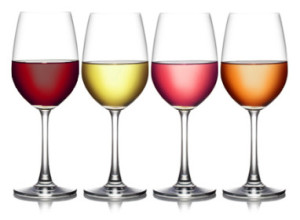Pain & Sulfuring.
Contrary to public opinion, wineries didn’t start adding sulfites to wine in 1987. That’s simply the year the US government dictated all wine containing more than 10 ppm, the smallest detectable amount at the time, be labeled with the warning “contains sulfites.”¹ If a winery can produce wine with less than 10 ppm of detectable sulfites they can forgo the warning label. I’ve sold organic wine for years and only once have I seen a label that read, “contains no detectable sulfites”. It may have been a misprint as the label should have read, “contains no detectable flavor”.
The warning label only applies to wines sold in America, leading many consumers to mistakenly believe that just those bottles destined for America are adulterated with sulfur while their European counterparts remain sulfite-free. The European Union has recently instituted a similar sulfur warning label so the idea that they are sulfite-free should soon be exposed as a myth – just like the idea that vampires can’t go out in daylight (like, have you even seen Twilight?).
Read MoreWild, Cultured or GM; Is Yeast a Fermenting Controversy?
Chapter Twelve. Part Five.
In an effort to tame the temperamental tribulations of fermentation, men have long tinkered with yeast, and as a result, winemakers now have many types of these little critters in their winemaking arsenal. Despite their differences, the one thing that all yeast organisms have figured out is how to convert sugar into alcohol, which is a far greater achievement than anything my college buddies have done with their lives.
Although wild yeast permeates the vineyards and wineries, many winemakers prefer to use cultured yeasts because they come from well-heeled families. Wild yeasts are uncultivated party animals and are therefore less predictable (of course unpredictable can also mean crazy-good). Think of it this way; uncultivated yeasts are like the wine bloggers of the fungi world but not quite as moldy.
Read MoreOf Esters & MLFs.
Chapter Twelve. Parts Three & Four.
The Ester Ouster
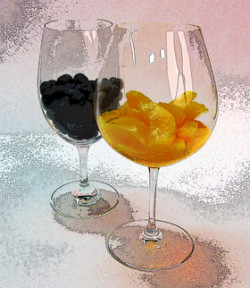 So what makes Cabernet Sauvignon smell like black currants and Viognier smell like peaches? The answer is only skin-deep – much like Jessica Simpson’s appeal or an outbreak of shingles.
So what makes Cabernet Sauvignon smell like black currants and Viognier smell like peaches? The answer is only skin-deep – much like Jessica Simpson’s appeal or an outbreak of shingles.
The cellular make-up of grape skins hold barely detectable aromatic compounds that are magnified during fermentation. Without fermentation these compounds would remain trapped inside the grape skins and then this would be a boring blog about grapes that no one will read … as opposed to a boring blog about wine that no one will read.
The cellular make-up of different grape varieties translates into aromas that are unique to that variety. During fermentation these compounds interact with yeast, alcohol and acids to create flavor substances known as esters. These esters also develop and evolve after fermentation, as chemical reactions continue to take place as wine ages. I also continue to develop new chemical reactions as I age but I control them with Depends.
Read MoreMaceration Makes Me Blush.
(But It Can Also Make Me Red Or White Or Even Orange)
Chapter Twelve. Part Two.
Raise your hand if you think red grapes are filled with red grape juice. Raise your other hand if you think rosé or blush wines are made from pink grape juice. If you have both your hands raised, do the hokey-pokey and turn yourself around because almost all grape juice, whether from white or red grapes, is clear (which is more than I can say about my writing).
As long as I’m straightening out this whole color thing, let me add white grapes are really green, yellow or orange, red grapes are referred to as black but the liquid and skins combine to produce purple juice. Got it? You can put your hands down now.
Years ago when I was studying for a WSET exam I bought a book about fermentation but I found it pretty useless … until I decided to read it. If you want to learn a thing (or two) you’re going to have to click this little read more button…
Read MoreFermentation Is Like Science, Except That People Still Believe In Fermentation.
Chapter Twelve. Part One.
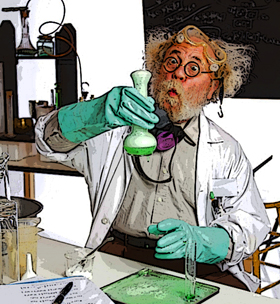 When I was a child, white-tailed bucks often ventured into my yard to feast on the apples collecting under the trees. Occasionally they would eat the rotten apples that had naturally fermented into wine and soon they’d be sloppily shouting to each other, “I really love you man!” Eventually they’d stagger into the woods in search of a stag party or wherever it is that drunken deer go.
When I was a child, white-tailed bucks often ventured into my yard to feast on the apples collecting under the trees. Occasionally they would eat the rotten apples that had naturally fermented into wine and soon they’d be sloppily shouting to each other, “I really love you man!” Eventually they’d stagger into the woods in search of a stag party or wherever it is that drunken deer go.
The apples had turned into fruit wine because fermentation occurs naturally when sugar comes into contact with nature’s abundant yeast organisms. Environmental factors such as oxygen, temperature, and global warming all play their part, but left alone Mother Nature is a passable winemaker. In fact, I’d say she’s an above average winemaker given some of the mediocre plonk I’ve had to endure during my tenure in the wine trade.
Read MoreLet Me Make This Clear; Racking, Fining & Filtering.
Chapter Twelve, Part Seven.
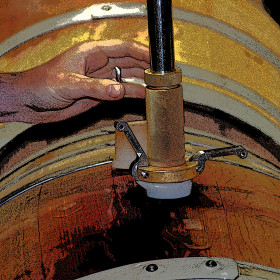 Once wine has fermented in a barrel, or been transferred into a barrel for aging from a fermentation vessel made of stainless steel, cement, or your bathtub, sediment will gradually form and settle to the bottom. If this thick, burgundy-hued sludge isn’t separated from the wine it could end up in your wine glass. Then it would only be a matter of time until Riedel introduced a line of spoons to go with their stemware.
Once wine has fermented in a barrel, or been transferred into a barrel for aging from a fermentation vessel made of stainless steel, cement, or your bathtub, sediment will gradually form and settle to the bottom. If this thick, burgundy-hued sludge isn’t separated from the wine it could end up in your wine glass. Then it would only be a matter of time until Riedel introduced a line of spoons to go with their stemware.
To get rid of sediment and other unwanted byproducts, most wine is racked, fined and filtered before bottling.
Read More

